Updated: August 17th, 2008
New York (Tadias) – Speaking about his life-long dedication to the fine arts, Maitre Afewerk Tekle instills in us the importance of using art to inspire people, to uplift nations and to create an optimistic view of life.
“What we do today must reflect today’s life for tomorrow’s generation and pave the way for the future generation,” he asserts with passion and reflection. He teaches us that “art is in every fabric of life.”
He was born in the town of Ankober in Ethiopia on October 22, 1932. Having grown up in an Ethiopia battling fascist Italian forces, Afewerk was acutely aware of the destruction of war and the need to rebuild his native home. Intent on acquiring skills that would allow him to contribute to Ethiopia’s restoration, the young Afewerk settled on pursuing his studies in mining engineering.
His family and friends, however, had already recognized his inner talent in the arts. Around town he was know for his drawings on walls using stones, and for possessing a curious and ever reflective mind. Despite his natural gravitation to the art world, at the age of 15 Afewerk was chosen to be sent abroad to England to commence his engineering studies.
Maitre Afewerk recalls being summoned by Emperor Haile Selassie to receive last-minute advice prior to his departure.
“To this day I cannot forget his words,” the Maitre says pensively. “The Emperor began by counseling us to study, study, and study.”
“He told us: you must work hard, and when you come back do not tell us what tall buildings you saw in Europe, or what wide streets they have, but make sure you return equipped with the skills and the mindset to rebuild Ethiopia.”
Maitre Afewerk confides that this sermon rang in his head each time he was tempted to seek the easy life, free from the responsibility of rebuilding his nation and uplifting his people.
As one of the earliest batch of African students admitted to exclusive boarding schools in England, Afewerk faced culture shock and the occasional strife caused by English bullies. Yet he remained steadfast in pursuing his studies. He especially excelled in courses such as mathematics, chemistry and history, but it was not long before his teachers discovered his inner talent for the arts.
With the encouragement of his mentor and his teachers, Afewerk decided to focus on refining his gift and enrolled at the Central School of Arts and Crafts in London. Upon completion of his studies he was accepted as the first African student at the prestigious Faculty of Fine Arts at Slade (University of London). At Slade, Afewerk focused on painting, sculpture and architecture.
Upon returning to Ethiopia, Maitre Afewerk traveled to every province, staying at each location for a period of up to three months, immersing himself in the study of his surroundings and absorbing Ethiopia’s historical and cultural diversity. He reflected on and pushed himself to become an Ethiopian artist with world recognition.
“I had to study Ethiopian culture,” the Maitre states, “because an important ingredient of a world artist is to have in your artwork the flavor of where you were born.”
He passionately adds, “My art will belong to the world but with African flavor.”
Above all, Maitre Afewerk worked diligently in the hopes of using his artwork as a social medium with which to highlight the history, struggles and beauty of his native home. Although he was educated abroad, he fought against what he called “the futile imitation of other artists’ works, Western or otherwise.’’

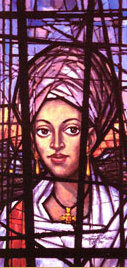
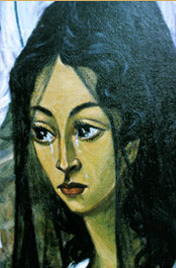
Left: Mother Ethiopia, 1963, 100x125cm Oil on Canvas. Middle: Lady from Wollo, 1991, 70x35cm,
Oil on Canvas. Right: Remenbrances: Detail of the Head, 75x125cm, Oil on Board
With the message of rebuilding Ethiopia still ringing in his ears, Maitre Afewerk quickly decided to relinquish the ministerial post assigned to him upon completion of his university studies, and opted instead to devote his full attention to painting and exhibiting his artwork both at home and abroad.
At age 22, Afewerk Tekle held his first significant one-man exhibition at the Municipality Hall in Addis Ababa in 1954. He followed up his success by conducting an extensive study tour of art in Italy, France, Spain, Portugal and Greece, paying particular attention to collections of Ethiopian illustrated manuscripts as well as acquiring skills in stained-glass artwork.
Returning home he was commissioned to create religious art for St. George’s Cathedral. He also worked on some of the first sculptures depicting Ethiopian national heroes. His designs and inspirations were soon printed on stamps and national costumes. Most notably, he conceptualized and designed the elaborate stainedglass window artwork in Africa Hall at the headquarters of the United Nations Economic Commission for Africa.
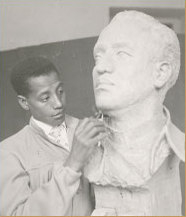
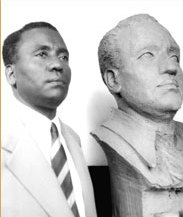
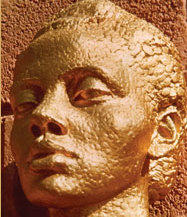
Left: The Artist Working on the head of H.E Tedla Bairu, the first Chief Executive of Eritrea, 1967.
Middle: The finished Sculpture & the Model of the same in Stone, 1967. Right: Head of a Jamaican
girl, Bronze, 1953
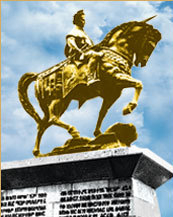
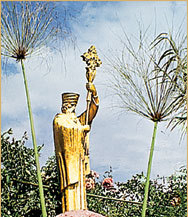
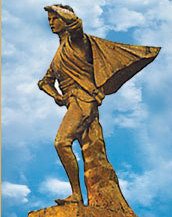
Left: Ras Makonen, Harrar, 1959. Middle: “Defender of his faith” (project for statue) Abuna Petros
square A.A., 1967. Right: “Young Defender of his country” (Project for youth square A.A. , 1959)
With the income and savings he acquired by selling his artwork Afewerk designed his own 22-room house, studio and gallery, which he nicknamed ‘Villa Alpha’.
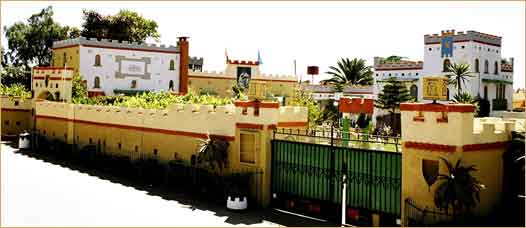
General view of ‘Villa Alpha’ from outside
By 1964 Maitre Afewerk had held his second successful exhibition, thereafter followed by his first exhibition abroad in Russia, the U.S.A. and Senegal. Touring African nations at a time when Africa was under the yoke of colonialism, Afewerk Tekle used his paintbrush to fight for the dignity and honor of African people.
Focusing on the struggles ensnaring black people, he shared his quest for liberation and equality, naming his artwork with titles such as Backbones of the African Continent, Africa’s Heritage, and African Unity.
“Your brush can be quite stronger than the machine gun,” he says. “I wanted to show how you can write Africa through your artwork, what it means to have liberty, to have your fellow humans completely equal.”
The theme of African independence and the interrelationship of African cultures are indelibly etched in Maitre Afewerk’s paintings.

Afewerk Tekle at Stanford University on March 7,
2004. (Photo: Tadias Archive)
Many art critics have tried, time and time again, to label and categorize his work as having either European or African influence, and sometimes even both. However, he tells us that “you should be free and liberated in your thoughts and style. Your art should speak to you in your hidden language.”
Maitre Afewerk notes that 10% of his work is considered religious art while at least 50% echoes Ethiopian influence. But there is room for him to explore and develop his own style that speaks to his inner muse.
Today, Maitre Afewerk’s art is known and celebrated throughout the world, and indeed he has achieved his dream of becoming an Ethiopian artist with world recognition. He has uplifted Ethiopia, and at the same time his art has been infused into the daily life of his community and fellow citizens.
Walking or driving around Addis few years ago, it was difficult to miss his art projects depicting today’s heroes such as Haile Gebresellasie. At the bottom corner of the painting there is an Amharic phrase that says it all: Yitchalal! (It’s Possible!).
“At the end of the day, my message is quite simple,” he says. “I am not a pessimist, I want people to look at my art and find hope. I want people to feel good about Ethiopia, about Africa, to feel the delicate rays of the sun. And most of all, I want them to think: Yitchalal!
—
Photos of art work from maitreafewerktekle.com. Learn more about the artist at the same website.
About the Author:
Tseday Alehegn is the Editor-in-Chief of Tadias Magazine. Tseday is a graduate of Stanford University (both B.A. & M.A.). In addition to her responsibilities at Tadias, she is also a Doctoral student at Columbia University.

I am proud to be an Ethiopian!!
hi,
afewerk tekile is a great man. GOD bless u .
I have a one palying card – a Joker – by Maitre Afewerk Teklé that my mother saved when she lived in Addis in the early 1970. It represents a devil like creature in red flames.
I treasure the card.
Let the almighty GOD give u long life .Afeworek you the treasure of Ethiopia and the shining gold of Africka.We Ethiopians who belive in our glories history of the past always remeber you as a patriot of our beloved mother land and a highly qualified artist. we love you for ever God bless you Afework.
Selam All…
As an Ethio-Muslim, I disagree that he represents Ethiopia as a whole. {His works do not reflect Ethiopia’s Muslim heritage}.
Tarik
Afewerk is an Ethiopian icon and a devoted patriot. I love him.
To Tarik:
እስከ መቼ ነው እንዲህ አይነቱን ተንኮል የተላበሰ ጥሩ መልእከት ያልያዘን ወሬ የምናቆመው? አንድ ሰው የፈለገውን መሆን ይችላል። ለመሆኑ በምን ላይ ተመርኩዘህ ነው ስራው የኢትዮጵያውያን ሙስሊሞች አያካትትም የምትለው?
አንድን ነገር ስትጽፍ በማስረጃ ብታቀርበው ተደጋፊነት ይኖረዋል። አለበለዚያ ግን ጹሁፍህ ከአሉባልታ ውስጥ ይመደባል።
to Tarik
Hey bro,
We are talking about one of the world’s Most Honorable Maitre Artiste.
Laurent Afework Tekle not only represents Ethiopia but Africa and the whole world.
You are a great man of the world !
እጅግ በጣም የተከበርክና የታፈርክ ሰው ነህ ደግሞም በራስህ አለም መኖርሀ ታላቅ ሰጦታ ነው